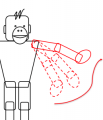Virginia Morell
Source - http://www.sciencemag.org/news/2018/02/chimpanzees-bonobos-and-even-humans-may-share-ancient-body-language
Want to say “Hello,” but don’t know the local language? Try waving your hand. Such gestures, common among humans, are also surprisingly similar among chimpanzees and bonobos, our closest great ape relatives. Now, a new study has identified numerous gestures that mean the same thing to both species. That suggests these signals have biological underpinnings and could be inherited from our last common ancestor.
Gestures, signals often used to get someone’s attention or ask for or stop something, are not technically languages. They don’t have specific linguistic and grammatical rules or accepted vocabularies. But gestures still have meaning: Among chimpanzees, for example, scientists have documented that many of their movements—from mouth stroking to request food or arm raising to request grooming—are used to elicit specific responses from other chimpanzees. Researchers have now found something similar in bonobos, great apes closely related to chimpanzees but with longer legs, pink lips, and long hair that’s parted in the middle on their heads.
Scientists started by shooting and analyzing videos of wild bonobos in the Democratic Republic of the Congo. When a bonobo made a common gesture that brought a consistent, satisfying response from others, it was added to the list. For example, when one bonobo looked at another while loudly scratching one arm, the second often responded by grooming the first. Because the first bonobo was almost always satisfied by this response, the researchers concluded that a “big, loud scratch” is a request for grooming. The scientists next compared the bonobo gestures to those of chimpanzees, and found that their repertoires overlapped by about 90%, significantly more than “would be expected by chance,” says lead author Kirsty Graham, a comparative psychologist at the University of York in the United Kingdom.
Glossary
 Arm raise
Arm raise
This gesture is used by both species, but it has different meanings for each. Chimpanzees raise an arm to say “Give it to me,” or to ask another chimpanzee to move closer or farther away. A bonobo uses the signal to ask whether they can climb aboard, or to initiate grooming or copulation.
 Big loud scratch
Big loud scratch
Bonobos ask another bonobo to groom them by scratching a shoulder. Chimpanzees do the same, but the gesture may also be an invitation to travel together, follow, or climb aboard.
 Hand fling
Hand fling
A kind of slapping motion used by both chimpanzees and bonobos to tell one another to move away. Bonobos also use it to tell one another to stop doing something.
 Mouth stroke
Mouth stroke
Reaching out to touch or stroke the mouth of another chimpanzee or bonobo means “Give that to me.” It’s usually a request for food.
 Present (grooming)
Present (grooming)
Sitting down or standing beside another individual and presenting a body part, a gesture used by both species, means “Will you groom me?”
The similar gestures with similar meanings are probably part of “an old repertoire that’s biologically inherited,” says Graham, whose team reports its findings today in PLOS Biology. It’s likely that humans share in this, too, as many people seem to readily understand what the animal wants.
But some gestures are clearly learned or altered, not simply inherited, like the very exaggerated arm raise that Shiba, one male bonobo, made while simultaneously thrusting out his chest. He seems to do it to emphasize his request to another bonobo—and it works.
Because a high percentage of the gestures and meanings are shared by bonobos and chimpanzees, the researchers suggest that the same gestures with the same meanings may have also been used by the last common ancestor (Pan-Homo) of these great apes and humans. All three species, the scientists hypothesize, use these gestures (although human gestures do require further study) because they are inherited biologically. Alternatively, the apes could have evolved the gestures and their meanings independently, but the researchers consider this an “unlikely” scenario.
The study may raise more questions than it answers, however, says Richard Moore, a cognitive scientist at Humboldt University in Berlin. The paper, he notes, analyzes only “broadly categorized gestures” that would be “potentially comprehensible between [the two] species,” and does not demonstrate that bonobos and chimpanzees actually understand each other’s gestures. Moreover, the study does not include small, but important details that might differ between the two species’ gestures or vocalizations they might add when gesturing and that would make it more difficult for a bonobo to correctly interpret a chimpanzee’s gestures or vice versa.
Still, Moore says, “The data are interesting and a good starting point for future research.” Graham’s team is now launching a study to see how people respond to the apes’ gestures to find out how many of these humans understand, and whether they overlap with gestures we commonly use.
VIDEO = https://www.youtube.com/watch?v=yZa17tYe0TQ